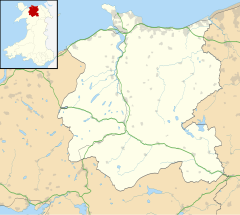Rhiwbach Quarry
| Rhiwbach Quarry | |
|---|---|

The ruins of the engine house and mill at Rhiwbach
|
|
|
|
|
| OS grid reference | SH739461 |
| Coordinates | 52°59′52″N 3°52′48″W / 52.9977°N 3.8799°WCoordinates: 52°59′52″N 3°52′48″W / 52.9977°N 3.8799°W |
Rhiwbach Quarry was a slate quarry located to the east of Blaenau Ffestiniog in Wales, at the far end of the Rhiwbach Tramway, which connected it to the Ffestiniog Railway. Commercial operation began around 1812, and it finally closed in 1952. It was the last Welsh slate quarry where workers lived in barracks on the site.
Rhiwbach translates as Little Hill, and was a remote site nearly 4 miles (6.4 km) to the east of Duffws, the eastern terminus of the Ffestiniog Railway in Blaenau Ffestiniog. The land on which it was located was owned by Lord Newborough, and small scale working of the site by local people needing roofing materials was carried out in the eighteenth century. More organised working of the site began in 1812, by two men from Penmachno and Yspytty Ifan, which gradually developed into a five-man partnership. The quarry was sold to Robert Owen Mousdale of Bryndyffryn, Llanrwst in 1849, and two men worked it for him.
Because of its remote location, the quarry faced a dilemma over transport. It lay to the east of the watershed, at the head of the Machno Valley, and the obvious route for exporting its products was northwards down Cwm Machno and Dyffryn Conwy to Trefriw quay. From there, slates could be loaded into river boats for onward transfer to Conwy, or directly into sea-going vessels. Although it was downhill, it was not ideal, as it involved around 14 miles (23 km) by cart to Treffriw, and then a further 10 miles (16 km) on the river. A shorter route to the south was possible, carting the slates to the Afon Dwyryd at Maentwrog, a journey of about 7 miles (11 km), and a further 8 miles (13 km) by boat to Ynyscyngar. However, from the quarry, there was a climb of 250 feet (76 m) in order to cross the watershed. Consequently, most product used the northern route to begin with, but from the 1830s, the southern route via Maentwrog was used.
In 1852, the Rhiw Bach Slate Quarries Company was set up in Manchester, with Charles Edward Cawley as its civil engineer, but by 1855 the company working the quarry was the Cambrian Slate Quarrying Company. The following year, the Manchester & Ffestiniog Slate & Slab Co Ltd was created, to buy out the quarry for £28,000. This was followed in 1858 by the incorporation of the Festiniog Slate Quarry Co Ltd, with a capital of £100,000. It consisted of several directors from a similarly named company set up in 1853 to buy out the Penmachno Quarry, a little to the north, and construct a tramway to it from Blaenau Ffestiniog. In 1860, agreement was reached with the Ffestiniog Railway on rates for the carriage of Rhiwbach slates, and the construction of an Extension Railway, on which the Ffestiniog would supply the rolling stock for a period of 21 years. The extension, known as the Rhiwbach Tramway, was financed by the quarry, but built by the Ffestiniog Railway. It was largely completed in 1861, as two quarries began using it in early 1862, but it was not fully completed until 1863. In the meantime, Rhiwbach built a wharf at Porthmadog in 1861, and carriage of their slates on the Ffestiniog Railway was first recorded in 1863, when 3,964 tons were transported.
...
Wikipedia

